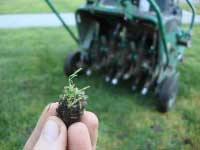|
 Lawn aeration is basically punching holes in your
lawn in order to make it healthier. Aerate means ‘to
provide air’ or ‘ventilate’ and that is what a
person does when they aerate their lawn. Aeration
is done by either pushing a pole into the lawn or
‘coring’ – pulling a block of soil out of the grass.
Coring the lawn typically brings up a plug of grass
that is ¼ to ¾ inch in diameter and 2 to 3 inches
deep.
Lawn aeration is basically punching holes in your
lawn in order to make it healthier. Aerate means ‘to
provide air’ or ‘ventilate’ and that is what a
person does when they aerate their lawn. Aeration
is done by either pushing a pole into the lawn or
‘coring’ – pulling a block of soil out of the grass.
Coring the lawn typically brings up a plug of grass
that is ¼ to ¾ inch in diameter and 2 to 3 inches
deep.
Why do this to your lawn? There are a
number of reasons people aerate their lawn: packed
down, tight soil will loosen up and allow the root
system to grow better; the root system is better
able to receive water when the soil is loose and can
soak up the water; oxygen allows the soil and roots
to ‘breathe’ making a lawn healthier; aeration helps
to break up thatch and organic supplies –
fertilizers – along with nutrients obtain access to
the root structure.
Once the aeration
process is completed, the lawn will look messy
because all the ‘blocks’ or ‘plugs’ pulled up by the
power aeration machine will be left behind on top of
the grass. It will be hard, but leave them there.
They will break up and return to the lawn and act as
nutrients. After a week or two has gone by, it will
be time to mow the grass again and the left behind
‘cores’ will begin to blend into the grass and soil.
Some people believe they can take a
shortcut when it comes to aeration and slip on
spiked shoes and jump or hop around their lawn;
however this only makes stabs or slits in the
surface of the lawn. This will not assure that the
grass, air, soil and water will find one another to
create a healthier lawn. By pulling out plugs of
grass and soil, a lawn owner knows that the roots
will reconnect to one another, and with the soil, in
a much straighter, healthier fashion than the
knotted mess they are in now that causes brown
patches, thatching, weeds and crabgrass. Few lawn
experts will recommend the ‘spiked shoes’ for small,
localized area, although true aeration by coring or
pulling out plugs is the best way to achieve and
maintain a rich, healthy lawn.
Performing
core aeration should be done to correct problems of
thatch swelling or soil compaction and not as part
of a routine lawn care program. Areas of high foot
traffic, slow drainage after a rain and rapid
browning during the summer months are all signs of
compressed soil problems or thatch
buildup.
A simple test to see if the lawn
need aeration would be to take a garden hose to it
and if the water does not soak in immediately, then
there is probably a problem. The wooden match stick
test could also tell someone if their lawn is
compacted – an individual should be able to press a
wooden match stick into the soil easily.
|